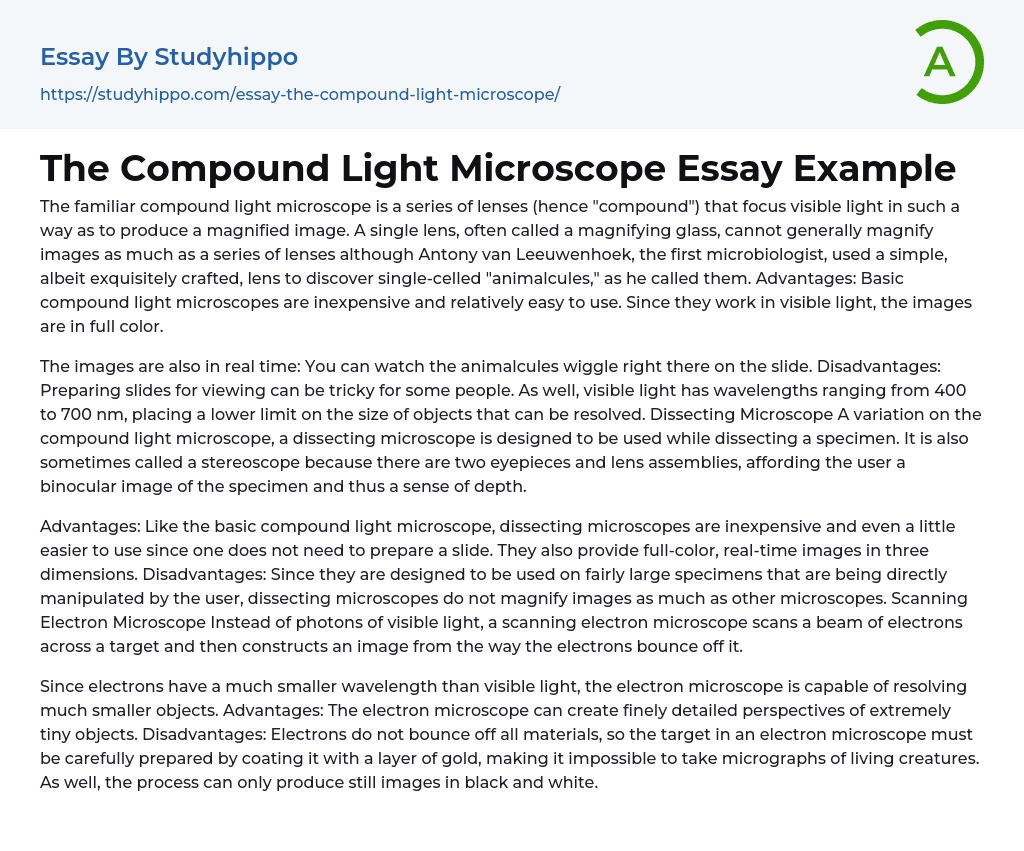The compound light microscope is a well-known lens system that utilizes visible light to generate an enlarged image. In contrast to a magnifying glass, it typically offers greater levels of magnification. Antony van Leeuwenhoek, the initial microbiologist, employed a meticulously constructed lens to uncover single-celled organisms known as "animalcules." Basic compound light microscopes are both cost-effective and user-friendly. Additionally, they yield full-color images due to their utilization of visible light.
The images can be observed in real-time, allowing direct observation of the movement of the animalcules on the slide. Nevertheless, there are drawbacks to consider. Firstly, slide preparation may prove challenging for some individuals. Moreover, the use of visible light restricts precise visibility of objects regarding their size due to wavelengths ranging from 400 to 700 nm. Another microscope variant called a dissecting microscope or stereoscope caters specifical
...ly to specimen dissection. It incorporates two eyepieces and lens assemblies that produce a binocular image of the specimen, resulting in a perception of depth.
Dissecting microscopes are advantageous in terms of affordability and ease of use. They can generate real-time, full-color 3D images without the need for slide preparation. Nevertheless, they have lower magnification capabilities than other microscopes as their design is focused on directly manipulating larger specimens.
In contrast, scanning electron microscopes employ electron beams instead of visible light photons to scan a target and construct an image using reflected electrons.
The electron microscope has the ability to resolve much smaller objects because electrons have a smaller wavelength compared to visible light. One advantage is that it can create finely detailed perspectives of extremely tiny objects. However, there are also disadvantages. Electrons do not bounce off all materials, so careful
preparation is required by coating the target with a layer of gold. This makes it impossible to capture micrographs of living creatures. Additionally, the process can only produce black and white still images.
- Organic Chemistry essays
- Acid essays
- Calcium essays
- Chemical Bond essays
- Chemical Reaction essays
- Chromatography essays
- Ethanol essays
- Hydrogen essays
- Periodic Table essays
- Titration essays
- Chemical reactions essays
- Osmosis essays
- Carbohydrate essays
- Carbon essays
- Ph essays
- Diffusion essays
- Copper essays
- Salt essays
- Concentration essays
- Sodium essays
- Distillation essays
- Amylase essays
- Magnesium essays
- Acid Rain essays
- Incandescent Light Bulb essays
- Agriculture essays
- Albert einstein essays
- Animals essays
- Archaeology essays
- Bear essays
- Biology essays
- Birds essays
- Butterfly essays
- Cat essays
- Charles Darwin essays
- Chemistry essays
- Dinosaur essays
- Discovery essays
- Dolphin essays
- Elephant essays
- Eli Whitney essays
- Environmental Science essays
- Evolution essays
- Fish essays
- Genetics essays
- Horse essays
- Human Evolution essays
- Isaac Newton essays
- Journal essays
- Linguistics essays




